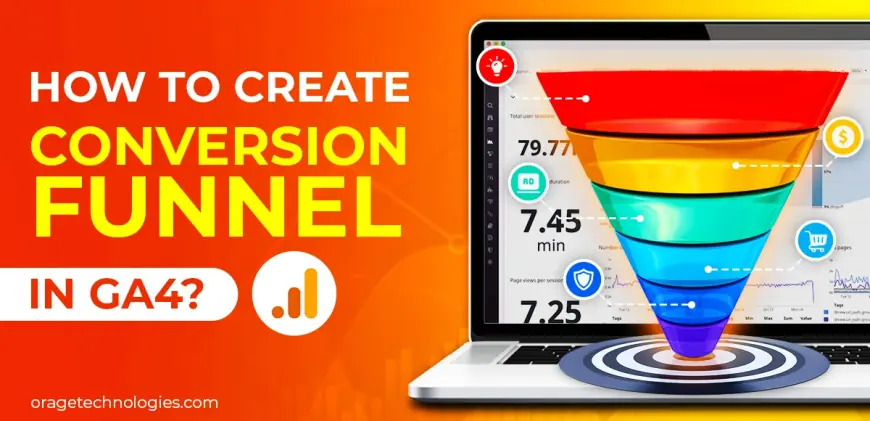For Better Optimization: Understanding the Conversion Funnel in GA4

In today's ever-growing competitive digital world, knowing how visitors are using your digital assets can't be overlooked. If you're generating eCommerce or capturing leads, understanding the conversion funnel in GA4 (Google Analytics 4) provides actionable insights for getting better results.
GA4 allows organizations to know if user journey was tracked accurately - from the first touch point to conversion. Once organizations know user journey/experience, they can pinpoint funnel blockages, improve engagement strategies, and make better data-driven optimization efforts for keeping users on the journey.
Understanding the Conversion Funnel in GA4
Conversion funnel in GA4 is a visual representation of the beginning and ending paths of users on your website/app as they interact with your digital content to reach a defined goal. There could be many paths (steps) but typically have some commonalities such as the user views an item, adds an item to cart, and/or makes a purchase - or maybe they read an article, sign up for a newsletter and/or fill out a form.
The funnel will help provide answers to the following key questions:
-
Where are users dropping out/at what step?
-
Which of the interactions have the closest correlation to successful conversions?
-
Are the marketing campaigns resulting in productive engagements?
The Strategic Benefits of Funnel Tracking in GA4
GA4 funnel exploration goes well beyond surface metrics. It provides:
-
A detailed view of how users are flow on and through your digital properties
-
More granular segmentation based on device, geography, campaign, and other factors
-
Insight into user drop-off at each stage
-
Information you can effectively act upon to improve UI/UX and content strategy
-
Metrics to show the impact of your marketing efforts to increase conversions
If these views are configured properly, they provide critical information to change each phase of the customer journey.
Typical Conversion Funnel in GA4 Stages
While funnels can be provider-specific and goal-specific, they typically consist of five stages:
-
Acquisition – Users arrived through organic search, paid ads, referring site, or social
-
Engagement – Users engaging with your site looking at products or content
-
Conversion – User completed the goal (purchase, sign-up, etc.)
-
Retention – Users returned - or engaged again, decreasing churn
-
Advocacy – Happy users - will talk about your brand and increase referrals
At each stage your funnel can be optimized to improve the overall conversion rate, and drive long-term loyalty.
Building a Funnel in GA4: A Technical Walkthrough
Once you have decided to create a funnel in GA4:
-
Go to your GA4 property and go to Explore.
-
Press the Blank option to begin a new report, and select Funnel Exploration.
-
Name your exploration (for example "Checkout Journey").
-
You can also use the pencil icon to specify each funnel step using an event or page view (for example product_view, add_to_cart, begin_checkout).
-
Be sure to set conditions and filters correctly so you can map each leg of the user's journey.
-
Select Closed Funnel (stepwise) or Open Funnel (nonlinear navigation).
-
Select Trended Funnel if you want to visualize any changes over time.
Enabling funnels in GA4 will help teams identify when and where users drop off and figure out how to close those gaps.
Optimizing Funnel Insights
With your funnel running you should then be able to identify and leverage certain of GA4's abilities to create more depth of insight like:
-
Drop-off Visualization: Identify points of friction with a visual and real-time drop-off analysis.
-
Comparative analysis: Getting performance breakdowns by device, user type, traffic source, region.
-
Elapsed time between funnel steps: How long did it take users to move from one step to the other.
-
Next steps after a stage: what did users do after exiting at a stage.
Going to this level of detail can convert raw data into business intelligence.
The Importance of Tracking Conversions
Make sure to track your important events as conversions in GA4
Like before, access the same gear icon and navigate to Admin > Events
-
When you find your most important events, mark this event as a conversion
-
Access the Funnels > Goals report to see your funnel
Keep in mind that conversion data can take 48 hours to appear for your funnels report, but you can check the real-time event tracking using debugging tools like Google Tag Assistant.
Resolving Funnel Performance
You may have performance issues when your Funnels say "0 conversions" and you have:
-
Waited at least 24-48 hours since the event was triggered?
-
Verified the tracking tags are firing correctly on the appropriate pages?
-
Selected the correct date range?
-
Checked that event names and page paths are the same in reviewing each step of the funnel?
Usually, most issues will likely be at the configuration level.
4 Practical Strategies to Improve Your Conversion Rates
To improve your conversion rates, you might want to think about using all of the following mechanisms:
-
Behavioral Funnels: Use a set of funnel data in combination with session recordings or scroll-depth data.
-
Heatmaps: Use a heatmap to see how your users act on pages that are essential to your business.
-
User Recordings: Watch what happens as users run into those friction points in real time, including which buttons they click.
-
Micro-Surveys: Use a user intent feedback and friction survey to ask users directly.
All of these ideas combined will help you learn more about the "why" behind the data you're looking at.
Funnel Example - Generating Leads
If your goal is to generate leads, you might want to consider a basic funnel like this:
-
Landing Page Visit
-
Click CTA (e.g., "Download eBook")
-
Complete Form Fill
-
Land on Confirmation Page
You can do this via custom events or predetermined page paths, which will align to get a sense of the total quantity of leads or lead quality.
Final Thoughts: Data-Driven Growth with Funnel Optimization
When effectively harnessed, the conversion funnel in GA4 provides unparalleled visibility into the user journey and the effectiveness of your digital approach. It reveals where your funnel works, where your funnel fails, and most importantly, where it can be optimized.
In a digital landscape where every click matters, a properly configured funnel is not just a nice-to-have, it is a necessity.
FAQs
Q: Does GA4 have funnels for both websites and mobile apps?
Yes, GA4 tracks the users journey in both environments using a combined data model.
Q: What is the difference between funnel to path exploration in GA4?
Funnel exploration shows completion/drop off by defined steps while path exploration shows steps taken to complete an event.
Q: Can I add monetary values to my funnel conversions?
Yes, you can implement conversion values either in GA4 or put in place through Google Tag Manager during your event configuration.
Q: Can funnels be retroactive in GA4?
Yes, in contrast to Universal Analytics, GA4 funnels can be applied retrospectively as long as the events in question were tracked.
What's Your Reaction?
 Like
0
Like
0
 Dislike
0
Dislike
0
 Love
0
Love
0
 Funny
0
Funny
0
 Angry
0
Angry
0
 Sad
0
Sad
0
 Wow
0
Wow
0
















































